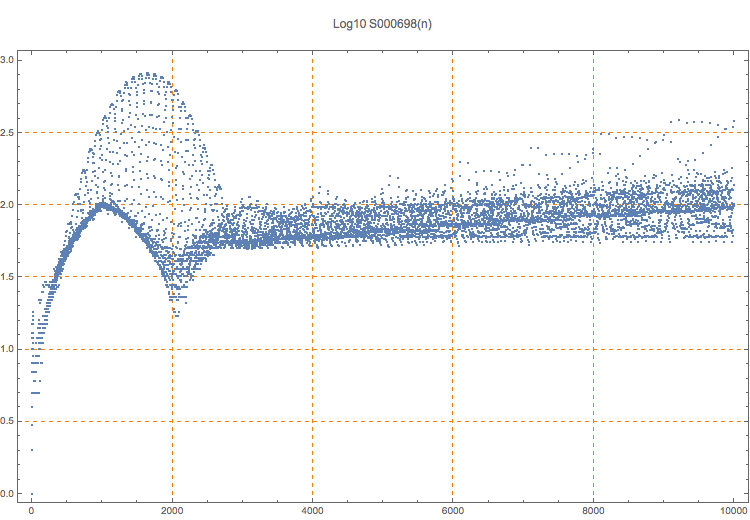Number of palindromic triples that sum to n.
1, 1, 2, 3, 4, 5, 7, 8, 10, 12, 13, 15, 16, 17, 17, 18, 17, 17, 16, 15, 13, 12, 11, 10, 9, 8, 7, 7, 6, 6, 6, 6, 5, 7, 6, 6, 6, 6, 6, 6, 6, 6, 6, 5, 8, 7, 7, 7, 7, 7, 7, 7, 7, 7, 5, 9, 7, 7, 7, 7, 7, 7, 7, 7, 7, 5, 11, 8, 8, 8, 8, 8, 8, 8, 8, 8, 5, 12, 8, 8, 8, 8
0
The order of the palindromes in the triple does not matter. Banks states that 49 is an upper bound. Could 3 palindromes be enough? Three works for the first 30000000 numbers. See S000699 for sums of two palindromic numbers. Note the similarity of the plots for 300000 and 30000000 terms. This sequence is the same as A261132. See sequences S000700-S000708 for similar sequences in other bases.
T. D. Noe, Plot of 10000 terms
T. D. Noe, Table of 10000 terms
T. D. Noe, Plot of 300000 terms
T. D. Noe, Plot of 30000000 terms
William D. Banks, Every natural number is the sum of forty-nine palindromes, arXiv 1508.04721 (Aug 19 2015)
Javier Cilleruelo and Florian Luca, Every positive integer is a sum of three palindromes, arXiv 1602.06208 (Feb 19 2016)
Eric W. Weisstein, MathWorld: Palindromic Number
Example: The first few palindromes are 0, 1, 2, 3, 4, 5, 6, 7, 8, 9, 11, and 22. Hence, there are five triples that sum to 32: 22+9+1 = 22+8+2 = 22+7+3 = 22+6+4 = 22+5+5.
(Mma) palindrome[b_Integer, n_Integer, del_] := Module[{c = IntegerDigits[n, b], d}, d = If[del, Join[c, Reverse[Most[c]]], Join[c, Reverse[c]]]; FromDigits[d, b]]; tp1 = Table[palindrome[10, n, True], {n, 99}]; tp2 = Table[palindrome[10, n, False], {n, 99}]; tp3 = Union[{0}, tp1, tp2]; Transpose[Take[Tally[Sort[Flatten[Table[tp3[[a]] + tp3[[b]] + tp3[[c]], {a, Length[tp3]}, {b, a, Length[tp3]}, {c, b, Length[tp3]}]]]], tp3[[-1]] + 1]][[2]]
Cf. A002113 (palindromes in base 10), A261132, S000699-S000708, S001015.
nonn,base,nice
T. D. Noe, Aug 26 2015
